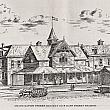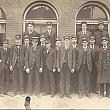
The Street Railway System of Grand Rapids: Its Cable, Steam, Horse and Electric Power Lines
Street Railway Company
The street railway system of Grand Rapids is divided between the Street Railway Company of Grand Rapids and the Valley City Street and Cable Railway Company. These two control many lines radiating from the business center to all parts of the city, so that Grand Rapids has a street railway service superior to that of almost any place of like population, in number of miles of track, number of lines, number of cars, speed and frequency of cars, and other desirable points.
The city is also upon the eve of a great—in fact a revolutionary change in its street railway service—from horse power to electricity, accompanied by a very large extension of lines, tracks, cars, and other permanent plant. The street railway service is notable for convenience of location of the several lines, so as to fairly accommodate the whole city, civility and attention of car employees, regularity of service, and good appearance.
The Street Railway company of Grand Rapids at present operates twenty-six miles of track, including a steam dummy line about two and one-half miles long to Reed’s Lake summer resort, where the company own grounds and a pavilion upon the finest location on the banks of the lake.
This company controls five lines, employing 180 men, seven barns, its own car shops, 120 cars, and 488 horses, making a daily travel of 4,500 miles, and carrying 4,500,000 passengers during the year ending on the 30th of June last. It has a capital of $1,000,000 invested, and proposes to spend $500,000 more in converting its lines to the electric system as rapidly as possible. This will involve building a power house, with 600 horsepower engines, dynamos and other machinery; the equipment of all its cars with dynamo-motors, and the building of many new cars, besides establishing lines of wires upon permanent iron or steel poles, for the overhead system of transmitting power. The average rate of speed of its horsepower cars is now five and one-half miles per hour. Under the electric system it will be privileged by its charter to make a speed of twelve miles per hour everywhere except in the business portion of the city. All its lines run without change of cars, and all take in as part of their routes, the center of business.
The various lines of this company are:
- Canal, Monroe and Division Street line, five miles from the city limits north to the city limits south, running through the business part of the city.
- Wealthy Avenue and Scribner Street line, five miles from the city limits east through the business center to the city limits north on the West Side.
- Stocking Street and Jefferson Avenue line, four and one-half miles from the north end of Stocking Street to Bridge Street, through the business center to South Division. Blakely Avenue, Jefferson, and Hall to the cemeteries.
- Cherry Street and Eighth ward line, four and one-half miles from the east city limits to the southwest city limits through the business center.
- Bridge Street line, two and one-half miles from the west city limits through the business center to the Union Depot.
These lines, it will be observed, traverse the full length and breadth of the city in every direction, at convenient distances, running cars on all at intervals of ten minutes, except the first, which runs cars at five minute intervals.
Valley City Street and Cable Railway Company
The company has been operating between two and three miles of cable road and their horse car lines. But they have been constructing within the past three months some four miles of additional cable road. They have a capital invested of $465,000; employ 150 men, with ten horse and forty-four cable and grip cars now in use or to be so within a few weeks, and own a large and fine power house, with powerful machinery of the latest styles. The average speed of their cable cars is from six to eight miles per hour.
Their lines are:
- Lyon and Ottawa Street line (cable), from near the east city limits to the business center on Canal Street, and up Canal to Bridge and Ottawa to near the D., G. H. & M. depot, East Side.
- Grand Avenue and Bridge Street line (cable), from near east city limits to Bridge, Ottawa and the business center.
- Fulton Street line (cable), city limits east, Fulton to Union, to Lyon and business center.
- West Third Ward line (cable), from Pearl Street and business center to city limits by Louis, Spring, Wealthy Avenue, Sheldon, Wenham Avenue and Lafayette Streets.
- Grandville Avenue line (horse), from Canal Street and business center to city limits south on Grandville Avenue.
- West Fulton Street line (horse) Fulton, Straight, Jackson, Pine and Bridge and business center.
- Barclay Street line (horse), Lyon, Barclay, Coit, Trowbridge and Clancy to D., G.H. & M. Track.
- Ionia Street line, south on Ionia to city limits.
This company has purchased four lots on the corner of Highland Avenue and Lafayette Street, where it is erecting a new powerhouse to contain engines to develop eight to ten thousand horsepower.
Besides these the dummy steam line to Reed’s Lake, the Tibbets line now building to Reed’s Lake, and the steam line to the Soldier’s Home are all really street railroads, and must in a few years take their places in the street railway system with the usual regular street service, whatever motor they may employ. As soon as the present project of the Horseman’s Association to construct a mile track and trotting park in or near the city is fairly settled, there will doubtless be one or more new street railways opened to that park.
The Grand Rapids Eagle, 45th Anniversary and Holiday Issue, December 25, 1889.
Article posted April 17, 2014

 facebook
facebook
